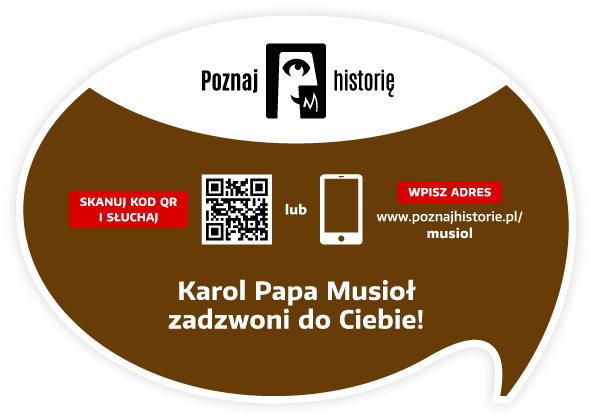Kaplica została wzniesiona na przełomie XV i XVI wieku. Pierwotnie nosiła nazwę „Kaplica Trójcy Świętej”. W jej centrum umiejscowiony jest kamienny sarkofag zmarłego 27 marca 1532 roku księcia Jana Dobrego - ostatniego opolskiego Piasta. Jan Dobry spoczął w ołowianej trumnie z książęcymi insygniami: mieczem i niebiesko-żółtym sztandarem księstwa opolskiego. Nad miejscem pochówku, dzięki staraniom hrabiego Johanna von Oppersdorffa, wykonano nagrobek. Tumbę przykryto płytą z czerwonego marmuru, a na renesansowym epitafium umieszczono herb opolskich Piastów. Jest na nim także napis w języku łacińskim, który po polsku znaczy: „27 marca 1532 roku zmarł wielmożny i sławny książę Jan, ostatni książę śląski w Opolu, Głogówku i Raciborzu wielce pobożny i szczodrobliwy wobec Boga i ludzi. Amen”. W kaplicy jest również sporych rozmiarów barokowy, XVIII-wieczny obraz przedstawiający drzewo genealogiczne Piastów. Według ostatnich ustaleń jest to dzieło Johanna Christopha Lischki z 1711 roku. Umieszczono na nim nie tylko imiona i herbowe tarcze kolejnych książąt, ale także ich postaci. Drzewo genealogiczne przedstawia powiązania opolskich Piastów z władcami polskimi, począwszy od legendarnych książąt Popiela, Siemowita, Leszka i Siemomysła, przez historycznych władców Polski Mieszka i Bolesława Chrobrego, a kończąc na wspominanym już opolskim księciu Janie Dobrym. Na uwagę zasługuje też znajdujący się w kaplicy późnogotycki tryptyk z Kostowa z 1519 roku. W jego części centralnej znajdują się trzy kobiece sylwetki: Matka Boża z Dzieciątkiem na rękach, a obok niej święte Barbara i Katarzyna. Na skrzydłach tryptyku namalowano św. Jana Chrzciciela i św. Jana Ewangelistę, a po jego zamknięciu ukazują się postaci apostołów świętych Piotra i Pawła.
Kaplica Piastowska
Teksty o wybranych miejscach w Katedrze Opolskiej oraz nagrania powstały w ramach projektu „Świadek wielokulturowości regionu opolskiego. Renowacja i konserwacja katedry pw. Podwyższenia Krzyża Świętego w Opolu”, współfinansowanego przez Unię Europejską ze środków Europejskiego Funduszu Rozwoju Regionalnego w ramach Regionalnego Programu Operacyjnego Województwa Opolskiego na lata 2014–2020 oraz środków własnych parafii katedralnej. Więcej informacji: www.renowacja.katedraopolska.pl

How it working
Aby posłuchać historii pomników w ramach projektu „Poznaj historię” należy wykonać kilka prostych czynności. Poniżej przedstawiamy krótką „instrukcję obsługi” - krok po kroku, tak aby w miarę prosto przedstawić Państwu sposób dotarcia do minisłuchowisk.

Trzeba mieć smartfon z aparatem fotograficznym. Obiektyw aparatu należy skierować w kierunku tabliczki informacyjnej znajdującej się tuż obok pomnika. Poniżej pokazujemy widok samej tabliczki oraz przykładowego jej umiejscowienia przy pomniku Karola Musioła w Opolu.

Po skierowaniu aparatu smartfona na kod QR znajdujący się w prawej części tabliczki na aparacie pojawi się ekran powitalny aplikacji, a następnie ekran z nazwą, zdjęciem pomnika i przyciskiem „START”.

Przycisk „START” uruchamia proces odtwarzania minisłuchowiska.
Następne kroki podpowie nam smartfon po wysłuchaniu historii lub przerwaniu jej odtwarzania. Prosimy o obserwowanie ekranu smartfona!

Inne dostępne opcje: krótka informacja o pomniku, autorze tekstu oraz nagrania, wykaz innych pomników w mieście objętych projektem "poznaj historię", mapka pomników do pobrania, film oraz linki do mediów społecznościowych.


Chciałbyś wdrożyć projekt również w swoim mieście?
ContactWybierz obiekt
Zobacz galerię
Pomniki w mieście przypominają nam historię miejsc, ludzi, nawiązują do ważnych wydarzeń. To także dzieła pracy artystów. Brąz, metal, drewno czy beton zamienione w formę pomnikowego obelisku skupiają uwagę. Lubimy przy nich siadywać, fotografować się, umawiać.
Poniżej pokazujemy Państwu, jak reagują osoby słuchające opowieści niemych zazwyczaj pomników. Jak się uśmiechają, zamyślają, czasem dziwią albo bawią…
Partnerzy projektu
Realizacja projektu „Poznaj historię” w każdym z miast wymaga zaangażowania wielu ludzi: programistów, grafików, autorów tekstów, aktorów, realizatorów dźwięku czy osób koordynujących całe przedsięwzięcie. To dzięki nim powstał te projekt.
Naszą ambicją jest, aby jego zasięg stale się rozszerzał. Dlatego dziękujemy obecnym partnerom i zapraszamy kolejne miasta, instytucje oraz firmy i osoby prywatne do współpracy!



Visit Social media:
Share Social media: